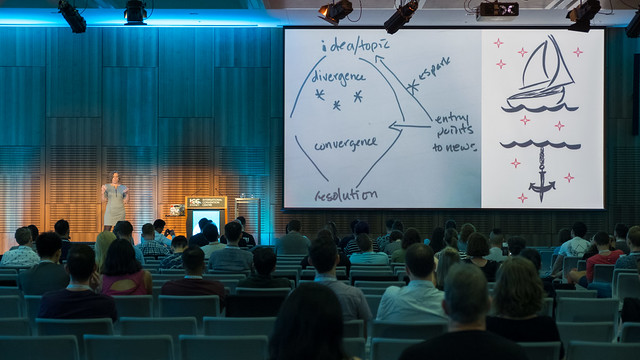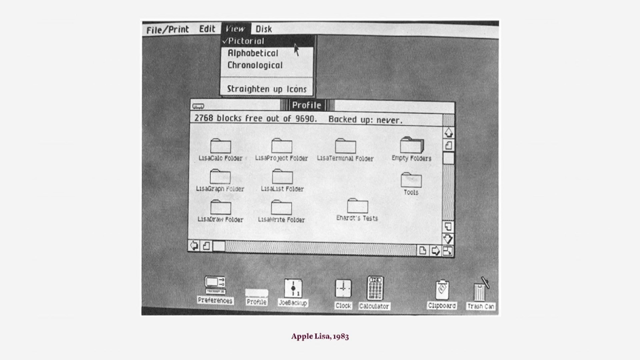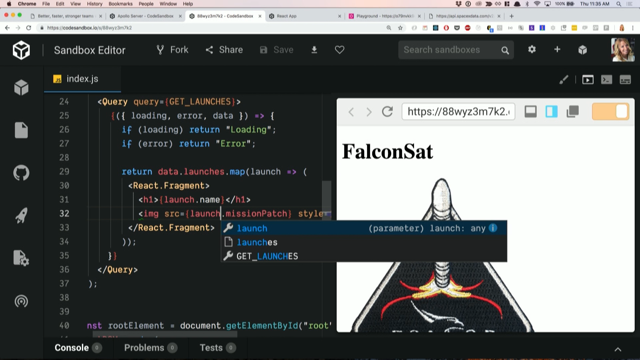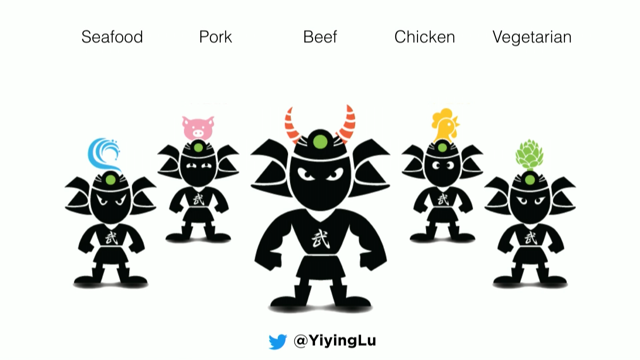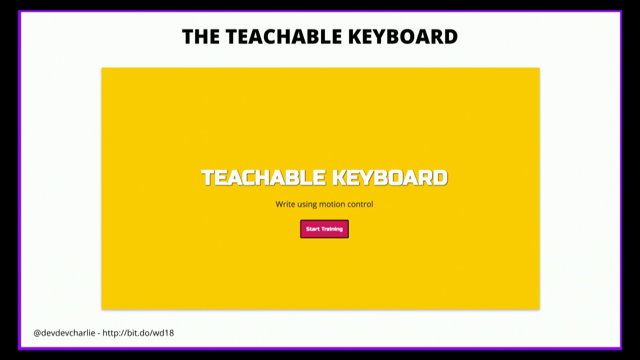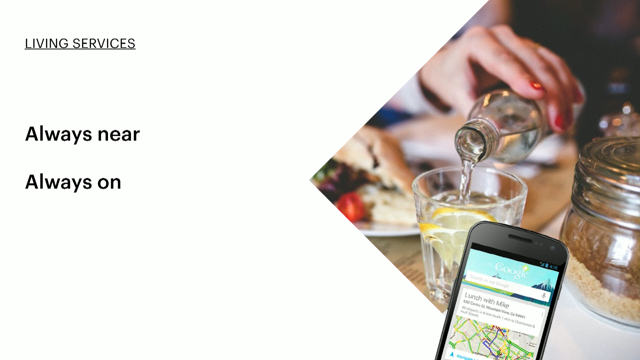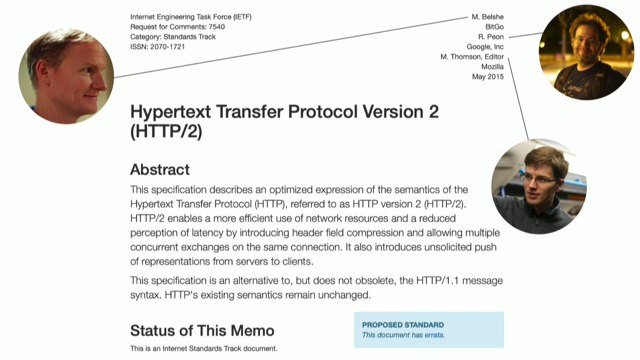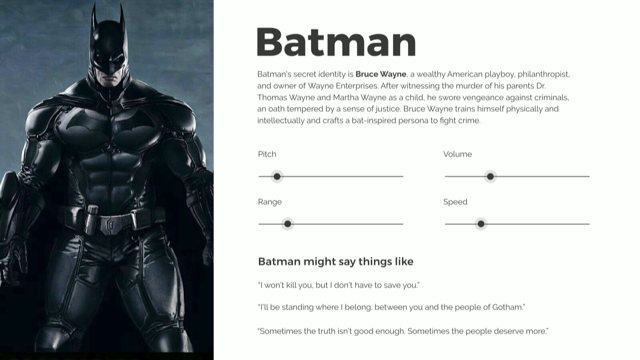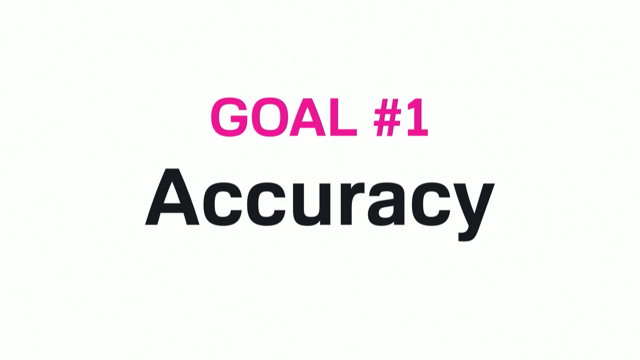
(upbeat music) - Thank you very much Josh, that may be the best intro I've ever received. So one of my opinions is that user research is the most powerful and accessible practise in design, because almost everything we do in the field is just an advanced application of a basic human capability.
The most important things that people have said to me in user research sessions in my long career of doing user research, this is one of them. "It's crazy.
"It's creepy.
"It's like I agreed "to coffee with this company and suddenly "they're proposing marriage." This was in a study, of a post-purchase experience, where someone had already bought a little something and they were receiving all kinds of exhortations to engage with the company further, and maybe buy more, and become one of the company's fans. And, the reason is was important that they used a metaphor was because it let us tell the client more specifically how they needed to change. So, it could have said something like this. Just it's kinda creepy, it makes me uncomfortable. That would have told us a lot, it would have let us tell the client, you know what you should probably dial it back.
Realistically, that might have lasted until marketing said again, hey let's dial this up.
Well what we were able to tell them because the participant used that particular metaphor about an over-enthusiastic date was, okay, here's what's going on, you're presuming a relationship that your customers don't feel that you have earned, and they're not even sure that they want you to earn it.
And so, you need to step back and rethink about your actual relationship with your customers. So here's another one, this is from the most tearful study I have ever done, in a remote research screen sharing sample of eight participants, five of them broke into tears.
I've done studies where we talked with people who were newly diagnosed with cancer and trying to find out more about their prognosis.
I've done studies with people who are losing all their money and trying to deal with becoming a completely different social in economics standing. But the study where the most people cried, was about a website where you could go and look for information about your ancestors.
This was a deeply, emotional task for people, and what happened is that they would get into seeking mode and they would find the name of an ancestor and they would discover that perhaps they could find maybe a court record of a wedding, maybe even a photo.
And it would get to the point where they would be going to view that photo and the site would throw up a cold bureaucratic pop-up that said give us $20 now.
And people would lose it, and they had felt such a connection to the thing they were about to see, and so this person said, again I'm really apologetic that they were crying.
But I was about to see my great-great-grandmother, and then it was just like a wall in my face. Ouch.
Once again they could have said, well everything's blocked and it really was frustrating, and that still would have given me some useful information, to share with the client.
There's a little something, slumbering, in what they actually did say.
Quiet, at peace but let me show you something from the, what the client actually asked us to do. They said, "We're seeing a lot of abandons "at the paywall.
"We want you to figure out "what's going on so that we can tweak it." Every conversation we had with them included the word wall, but it wasn't until the participant used the wall in a statement about, a metaphorical statement about how it made them feel. That the observation room suddenly got quiet, and people said oh, oh wow.
Okay, we really need to rethink this.
Now, we didn't go and tell them don't have a paywall, it's perfectly reasonable to ask for a subscription, and they needed to get paid, and there's absolutely nothing wrong with that. But when we all came to shared understanding of this concept of a wall, we could talk about what kind of wall they wanted to design for this point in their process.
So you can have a really hard blank opaque wall, that's terrifying, you can have a wall with a lovely gat in it.
You can have a nice low wall maybe even one that's run down a little bit.
There are a lot of different kinds of walls that can exist inn the world and using that metaphor, which actually was already embedded in the paywall concept, enabled us to have a conversation with the client that we couldn't have had without the participant giving us that.
So what's going on here? Metaphor's are a major stock in trade of human communication, we all swim in them all the time when we're talking in a shared language community.
Some of them become so common that people collectively forget they're a metaphor. If you're an english speaker you probably refer to the things on the bottom of a chair by the same word that you refer to the things on the bottom of your body:;legs or feet.
This is not true of every language, and if you, speak say Japanese where this particular dead metaphor is not used, you will get a very funny look if you talk about the leg of a chair.
It's a bit, like the way that we use, colour. It's as if we are experiencing one thing in terms of another, yes, but it gives us a common way to talk about something that's pretty abstract. So, if we were to be philosophical, one of the things that philosophers sometimes argue about and believe with this reference to Oliver, is whether you and I see the exact same thing when we talk about the colour red. But it almost doesn't matter if we do see the exact same thing, because at least we know that we're referring to the same thing. So if you tell me that something is red or silver or sky-blue, that's a very quick way for me to get a visual picture of what it is.
Metaphors perform a very similar function when people try to explain things or make a point about something a little more complicated.
Remember a few years ago when everyone was talking about Uber for this or Uber for that? Simple metaphorical thinking.
So Uber for Cupcakes could mean a delivery service that brings cupcakes to your door in app.
It could mean a company trying to disrupt the cupcake market through predatory pricing funded by extremely extensive VC grants.
Either of those things would be accurate, but Uber for Cupcakes is actually a much more efficient way to say either of them.
Metaphors can be really wild, in Yien's talk yesterday if you were there, she talked about dumplings, as a metaphor for primordial chaos because of the unknown that happens to you when you bite into a dumpling and you don't know what's inside. And I said, oh how exciting I'd love to explore that metaphor a little more.
Another kind of maybe more abstract metaphorical thinking in design, this is a set of posters created by NASA's jet propulsion laboratory in 2015. Where they wanted, during a time of diminishing funding for space exploration, to show the world that they still believed in the potential of humanities future in space.
So what did they do? They created posters that looked very much like the travel posters from the early 20th century, and so the metaphor is kind of in the form of what they're doing, this is also one of my favourite design objects from that year. And, they're using these metaphors to make this point, that hey we can go to space one day, we can still aspire to this, whatever the state of the government right at the moment. We even have a few in UX that we use all the time, this is one of my favourite dead metaphors. I bet you didn't think the last time you talked about a user journey about a really epic quest where someone is transforming in the course of travelling somewhere.
What's interesting about it, is you can use it to get, at some key underlying things of how designers think about their own work. Because there are a lot of words that we can use for travelling along a path, or going through a flow, or going through a sequence, and journey in some cases might be the right one, but sometimes, the thing that we think is really important because we're working on it as a job and we're passionate about our profession, is something people are just thinking of as maybe a commute trip, a jaunt.
Sometimes you get feedback like this, Look, this is not as important to me and we're influenced by that metaphor sitting there reigning the heart of our practise in the name of one of our most common artefacts.
I want us to look out for that.
I also wanna talk mainly about the metaphors that we get out of qualitative data sets.
Qualitative data sets are what you get typically out of open ended user research, so you get transcripts, you may get things participants said, you may get notes that your team made, you may get doodles that your team made, you may get photographs, you may actually come home with artefacts.
If you do a large enough study you'll come home with an absolutely daunting volume of all this stuff. And the big question for the team at that point, it's like great, you've done a good job at collecting all this data now how do we make sense of it? How do we bring this into a design that works for our users and whatever business we might be serving? Course we get all the post-its, so that's great. We atomize the feedback into little bits of insight and we cluster them, and this is a valuable thing to do. The other things that we might reach for in this area in particular, let's see if we can find something to count, let's see if we can appease the people who are really really excited about numbers by creating a number out of the qualitative data that we've got.
Let's see if we can draw something, and both of these things are very black and white, and I think it's kind of interesting that we convert things into their black and white forms, as we try to make the findings of our user research accessible to others who may not be part of our particular discipline. One of the things that we also use as a short cut is the idea of empathy, like we're doing this to create empathy.
I used to have in my Twitter profile actually, that my favourite tools were empathy and duct tape and I changed it to metaphor and duct tape, because I decided that metaphor was a better thing for us to aim for and close observation was a better thing for us to aim for than empathy.
And it's partly because I work in government, and so we'd work on public services and therefor the idea that I with as much privilege as I hold, as a white woman in the upper-ish reaches of the economy, that I can have true deep empathy with somebody who's experiencing generational poverty and perhaps at risk of losing their home, or their status, or custody of their children in a way that I've never been faced with, that would be kind of the height of arrogance. But, I can closely observe how this person experiences this, understand what language they use to describe their own situation, and with that come to a respectful understanding of what my design team ought to be doing. Now I've been told that I might fade out if I don't actually tap this there.
So, when we take some time to find the metaphors within a qualitative data set, and I don't just mean the ones that the participant might say as in the first quotes, but the ones that our team might come up with in discussing what's going on and in our synthesis sessions, even the ones that might be dead if we take the time to re-animate those dead metaphors, we often end up with a lot more interesting things that we could draw or could count, if we wanted to turn them into black and white, if we wanted to get to the colourful human side of our data set first. One way I like to explain metaphor, it's based on something I learned from this wonderful book, it's by the economist Daniel Kahneman, interestingly enough but it's really a psychology book. And he talks about our brains having two different ways of thinking, one is the very explicit, logical way where each piece builds on another and you can trace how it works, and the other one known as system one, is the very fast way that draws association. If you're expert enough in anything to have unconscious competence, you're using system one almost all the time you're doing that.
My favourite basketball player, Steph Curry, does not think as he dribbles down the court, pulls up about five feet between behind the arc and launches a shot.
He doesn't think, okay, I'm a little farther back than usual which probably means I'm gonna need to adjust the angle, this way and also that's LeBron coming at my face so I'm gonna jump to the side.
He just does it, he's got system one operating because he's got so much of a field of data about basketball games and basketball shots. All of us are practically Steph Curry, in our facility with using human language as members of a language community.
So we have this if not inborn developed through our lives ability to use system one to draw associations that are actually very very often correct, and so it's often very efficient to examine metaphors that people use.
People associate metaphor with poetry and, well they should, and you might think that that means well it's imprecise so I wanted to talk a little bit about poetry.
This is a absolutely flaming love poem, by the American poet Theodore Roethke, in which he describes a woman that he's besotted with. And one of the things he says, as he gets more and more worked up, is he says, "I swear she cast a shadow white as stone." And it's just one of those moments that gives you a bit of prickles and it doesn't make any sense if you read it out of the context of the poem. If we try to analyse it as data, if we tried to say, okay, in the presence of this woman that he is infatuated with a bunch of things change, and let's look at the correlations of how they change, probably can break them out into four dimensions. It's much less efficient than the metaphor that he uses, it's much less precise, than the metaphor that he uses.
So when we pay attention to a users subconscious or even unconscious associations, we get a lot more data to work with, that we can unconsciously surface and interpret to use in our designs. So I'll share an example, this was a study for a major american news organisation.
It was a large study, 45 75 minute interviews, so the stacks of data were mountains, we had transcripts, we had someone cartoon each persons description of how they checked news throughout the day, so we had drawings and this was a persona study, so we were looking to cluster behaviours. And we had a team of four user researchers. So most of us had sat in on most of the interviews, and we did synthesis along with the client. The most interesting thing that began to emerge after a couple of days of sitting in the room with the data, was that an awful lot of people had used specifically the word gem, when talking about their interactions with news.
It's not a super unusual word, but it's kind of an interesting word.
And as we looked at people that we already started, started to sort into behavioural clusters, a lot of people talked about gems in similar ways within those clusters, and we said we should probably examine this term gem, which is clearly a metaphor so.
Most obviously, gems are precious, as a statement of value.
Sure, there's an awful lot of ways though, that you can say value, and nobody clustered around any other particular one, gem was by far the most common one.
So we started looking, it's also not, it's not something you encounter a lot in modern life.
Like, yes, I have a gem on my wedding ring. Some people do, but it doesn't come up all the time, so we looked farther back a little bit, to look at sort of folklorically, historically, how do people talk about gems.
Well gems get hoarded by dragons, by mean people, they get displayed as a sign of power and wealth, by royalty and others who care about those things. And can be given as important gifts.
We identified these three behaviours and we said let's go look and see if any of the people who used that word are doing things like this. And sure enough, we had people who loved to find out about the news first, and not tell anyone that they knew, until other people had found out and they would say oh, I knew.
We had people who would send their friends a particular article, I picked this out for you, or particular restaurant or theatre movie, I picked this out for you, a gift.
And then we had people blasted all over their social media feeds how up on the latest they were.
So the fact that gem actually fit into a conceptional framework is what made us realise that this was an apt metaphor that we could use to bring to the client to show them something about, both how much people valued their product, and how people valued their product and what that made them do and therefor what behaviours they needed to support in the next version of their design. I'm not going to pretend this isn't messy.
(chuckles) These are real notes from that synthesis session, if this was in a museum it would have a little plaque in the corner, and it would say materials ball point on A4.
(laughing) And, we were playing around with a lot of concepts, and everybody wasn't very comfortable, but it was clear that there were a couple of clusters of behaviour. So there was kind of a heavy cluster where people looking into this pretty big name provider of news to kind of help them conclude what was going on, or for authorial voices that they really trusted, to kind of ground them. And there were people who were looking for inspiration or new directions to go, and so we have here a bag of rocks and a feather, and didn't really work. We tried to push the metaphor, it didn't go anywhere. I don't really remember how it happened, but at some point looking at the clusters of voice and hoard and I ought to do it, and authority versus escape, in my own opinion and the first to flow, somebody said, you know when you feel grounded where I am, or I wanted to take 'em somewhere, it sounds like boats.
I think this is an anchor and a sail, and everyone said oh, and then we had to go back and check through draw, okay actually what's going on here, we're really talking about divergence and convergence as broad clusters in a way that people use news and there's kind of a entry point there where you can come down to resolution, or you can come from an idea or topic out to finding out more with a spark.
And someone who can actually draw, put this together. Which became the centre of our whole presentation, the idea that there were anchor clusters and sales clusters, one to support all of those people in a future design.
And this resonated with senior executives it was something they could immediately grab onto, oh we get it.
Yes, an anchor and sail, I wanna be taken somewhere, I wanna be grounded, a little more detail, but that was the way it went.
So, one of the most interesting things about working with metaphor over and over is you start to find them a lot and you'll discover that if people describe something in several ways or explain something in several ways, it's virtually certain that one of those will be an apt of fitting a good metaphor, and so what I've started to do is adapt the practise of the five whys which I think is probably familiar to a lot of us to the five way.
Ask someone, see if you can elicit several different descriptions from them, because you will very likely come up with a useful metaphor.
So this coffee statement that we started out with, that was actually on probe telling more and more about that, and the person brought up coffee and it was clear to everyone in the room that they weren't just talking about the tasty morning beverage.
They were really talking about the safe early date where you meet at a public place, and you don't have alcohol because we're not quite sure about this person yet and it's possible that this goes through a million ups and downs, and maybe heavy dips like Maria talked about yesterday, but it's possible that at the end of their path, there's a life partnership.
And you don't want to over accelerate that path, or you're gonna be in a very awkward or perhaps even tragic situation.
So, I would like to suggest that everyone add to their repertoire of can you say a little more about that? Can you say that another way? And not just when you're in session with a participant, but when you're in synthesis with your team, thinking about what this means.
Any time someone is struggling, give them space to say it another way.
Maybe even encourage them to say it another way, because that next way could be the metaphor that's gonna get you to where you need.
And if you have a good metaphor, one of my very favourite obscure laws, Miller's Law, is something to apply. And it's basically assume that something someone says to you is true and then look at what would have to be true in the world, or their conceptual structure, in order for it to be true, or in order for it to make sense.
Following this is actually a really good way to exercise your metaphor capability, you kind of put out strange propositions, and make someone say, what would have to be true, in order for that to make sense? Okay, so question this for example, actually even though I'm telling you that these are innate capabilities, can we actually do more to set ourselves up to take advantage of these within research? And yes you can.
There's often some unpoetic work.
When I have a hard research problem I like to turn to our friends and social scientist, who do much more than rigorous qualitative work with much larger data sets, and in particular I find the process espoused in grounded theory by Kathy Charmaz to be particularly productive for kind of painting the colour, and identifying the metaphorical colour within a data set.
It's a step to process of going through a data set over a couple of times and tagging the things that are interesting phrases and that spark a connection for you, and you start to then connect those notes into solid analysis after a couple of tags. And one of the biggest guides, and this was always the tough part, you are a expert at this.
The thing that sparks your interest that makes you go, oh, that's a clever way to put it, that's an instructive way to put it.
That's absolutely real, that is the thing to look at. But don't forget the dead ones either.
So this is a group of city officials from the city of Oakland, California, actually physically applying colour to transcriptions of user sessions with highlighter pens, just as a way to get out what are the most interesting human pieces, these are government IT people, the last people you would think of designers although they make a lot of important design decisions. And this works for them, they can do this, everyone can do this.
But I'd would like to give you a little bit of help, as you start out on the journey of thinking about using more metaphor in your work, there are certain quasi universal things that make really interesting metaphors that are worth looking for, or maybe even worth bringing up in a synthesis session.
Things around love and human relationship, so when you're thinking about how does a participant feel about what you're researching, if they do like it, what kind of like is it? Do they feel sort of parental to it? Do they feel excited and impassioned by it? Do they feel not very strongly about it? You can get into some pretty good sets of concepts through that.
Food usual tors another great one, we actually had a food metaphor that was part of the same news analysis that I talked about the gems, and the anchor and the sail, and it didn't end up anywhere in the final presentation but it was an important part of or discussion. We started talking about vegetables and how each of these behavioural clusters would think about the news if it was vegetables.
Well, we had some people who would like to go to a restaurant and have the finest chef in town, assemble and plate a beautiful vegetarian meal for them. We had some people who'd really like to go to a farmer's market and pick their own produce, thank you, and they would make something great. We had some people who just really wanted to make sure that they got all the vitamins they were supposed to so these were the people who are like, look I know I need to be an informed citizen I really don't particularly enjoy the news but if someone would deliver me like a guaranteed box something like your towns newspaper page once was, I would feel like I was getting what I needed and I was like informed and that would be cool. Helped us actually re cluster the behaviour so we then got back to the point where we could put them into the bigger clusters than the anchor and the sail. Status and competition are great, are people trying to win something, is there a race that they're running, or is there something where they're trying to be the best or the most outrageous? One might say that the experience that they're describing might be ordinary? If I do a workshop on this, one of the things I have people do is reimagine the room, as if it was somewhere else. If we were under the sea here what kind of assembly is this? Is this a school of fish? Probably not, and that just hit as a metaphor that doesn't fit, so we'll talk about those in a minute. But asking those kinds of questions related to place, or even animals, People use animals a surprising amount.
Well this is kind of like a puppy, Oh really? Tell me a little more about how it's like a puppy. Someone described a button as a duck.
What? Well it's just always popping up there like it's quacking. Okay, maybe that didn't push further, but that was something to note and interrogate and figure out what was going on.
So the other thing is we do get into the very unromantic and unmetaphorical realm of spreadsheets.
I love them.
I love doing count tags, to pick up pieces of language that I might be investigating, and this right here is the formula that you need to quickly find at any point whether something that someone has said is all over your data set or not.
It's a real paint the page to the transcripts, this guy will get it done in about five seconds. One thing as well is that if you're working with metaphor, it can be a lot easier to work with bolder metaphors as you start describing what the motivations are, so if you work in a small business and it seems like people want competitive advantage, well that's a good motivation, it's important.
What if you were amp it up to winning, does that help you find any more interesting conceptional structures? What if you amp it up to victory, victory is a big deal.
What if you talk about madness over rule bending, or what if we all collectively use journey over trip because we wanna signal that something's important? It's a good exercise but it still has to work when you bring it back down.
So we look at some of our space posters.
There's something easier and brighter in some ways about this one that looks like, we're going to tame the Red Planet.
I can work with that metaphor set, pretty easily and then if we need to back down to okay, actually we're gonna explore how we might build something on a neighbouring world in our solar system at some point.
I can do that.
From looking at the subtleties of this admittedly absolutely gorgeous picture of the Venus that we might imagine that we could one day visit.
It's a lot harder to start there, you have to be almost as good as Theodore Roethke, to get really useful metaphors out of those types of subtleties. So be okay with going big.
I'm always asked, how you tell if it fits? And again, you have an internal barometer that tells you if it fits, an apt metaphor extends, it will fit into other clusters of concepts that are out there in the field, it will enhance your conversation.
People will get more excited in the room and attach onto, oh, yeah, it is like that because this other thing also fits.
Raw metaphors feel itchy and bullshit like almost nothing else on Earth, and I finally found a cool representation of what that's like.
This is the bicycle of life-long learning.
And it's worth noticing, it's a bicycle, so its purpose is locomotion through self-powered energy applied to the pedals, which are not even labelled in this drawing, but there's a lot of other stuff labelled and there's some really weird stuff like evaluation is the bell, and something else on the handle bars is the question and it's sort of like they took a bunch of things that had to do with life-long learning, and it seemed like a couple of them would fit the bicycle, so they went and they just turned a stick-on into a bicycle.
If you find yourself doing this, it would be relatively obvious if you're keeping yourself self aware, like oh this doesn't work and the primary piece of it, the pedals, is not part of our concept set. You can just let those go, there's a lot of metaphors in the world, there's a lot of metaphors out there, and the right one is out there somewhere.
So, I'd like to end this talk within a few minutes, by talking a little bit about how we bring other people into this.
I usually find it pretty easy to convince researchers, and often pretty easy to convince designers that this is a great thing to do.
Stake holders are a concern for almost everybody that I talk to about this.
How do I get regular old business people to some along into this more colourful, more human, less black and white, uh oh, way of working. So, it's gonna get a teeny bit advanced, this is going to be meta metaphor, so hold onto your butts. These two people, are probably familiar to all of you, Dorothy Gale and Charlie Bucket, and each of them had an adventure where they went from a pretty grey world into a much more colourful, much less rule bound, much less every day world.
And they both had pretty spectacular adventures, they met strange people, there were dangers that they encountered, they travelled around a bizarre landscape, everything was wildly colourful and disorienting. In Dorothy's case in the end, it was all an illusion. There was really nothing for her to do but get herself back to the grey world as fast as she could. In Charlie's case, some people broke some rules, but he ended up living in a chocolate factory and even the people that broke the rules, went home with trucks full of chocolate.
This presents a set lessons for us, if we're going to take people along on a metaphorical adventure.
You wanna tell people that you're doing that, for one thing, you don't want to sweep them up like a cyclone land 'em in an unfamiliar place and say, congratulations you're king of the world of metaphor. You wanna announce it, you wanna say well, we're offering a pretty cool adventure here, it's gonna be a little bit out of your comfort zone, but we'd really like your trust. Tell them as far as you can though, what they might expect. We're gonna be, we're not just gonna be doing usual Post-It stuff, we're gonna be working really pretty deeply with language, it's gonna be messy, like the ballpoint on A4, we might not get the right thing the first time. But we can trust this process, and be real, don't be the man behind the curtain.
Even though Wonka's probably manic in certain respects, it's much funner to be him, he keeps his promises. So I do encourage you to invite your team, to show them everything that you're doing with metaphor. But make the rules clear, make the boundaries clear. Most importantly, send them home with rewards. Send them home with real things that you find that they can intake into the design process. So, what happened with the anchor and the sail? Well, the company decided for the sale people, to offer a product that involved increased access to its extensive archives which stretch back more than 100 years.
So that those people, the kind of people often who open a tab with every interesting link that they see, could go deeper into topics that sparked them. And they decided, also, to increase the authorial voice that they presented on their home page, to support the people who are looking for that grounding, is the anchor people.
They went home with something from the strange adventure that they could really use.
But as the pressure on all of us to do everything in black and white and to do everything in numbers increases I really truly believe that we need more people working in the world of colour, and so that is my invitation. Come with me and work boldly in the world of colour and connection.
Thank you. (crowd applauds)
(upbeat music)
